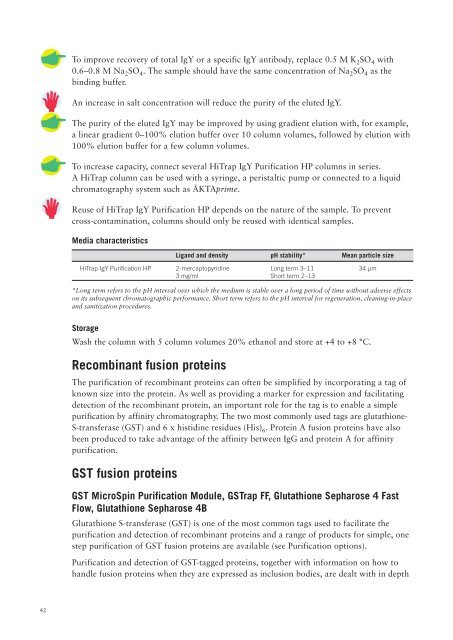Affinity Chromatography - Department of Molecular and Cellular ...
Affinity Chromatography - Department of Molecular and Cellular ...
Affinity Chromatography - Department of Molecular and Cellular ...
You also want an ePaper? Increase the reach of your titles
YUMPU automatically turns print PDFs into web optimized ePapers that Google loves.
To improve recovery <strong>of</strong> total IgY or a specific IgY antibody, replace 0.5 M K 2 SO 4 with<br />
0.6–0.8 M Na 2 SO 4 . The sample should have the same concentration <strong>of</strong> Na 2 SO 4 as the<br />
binding buffer.<br />
An increase in salt concentration will reduce the purity <strong>of</strong> the eluted IgY.<br />
The purity <strong>of</strong> the eluted IgY may be improved by using gradient elution with, for example,<br />
a linear gradient 0–100% elution buffer over 10 column volumes, followed by elution with<br />
100% elution buffer for a few column volumes.<br />
To increase capacity, connect several HiTrap IgY Purification HP columns in series.<br />
A HiTrap column can be used with a syringe, a peristaltic pump or connected to a liquid<br />
chromatography system such as ÄKTAprime.<br />
Reuse <strong>of</strong> HiTrap IgY Purification HP depends on the nature <strong>of</strong> the sample. To prevent<br />
cross-contamination, columns should only be reused with identical samples.<br />
Media characteristics<br />
Lig<strong>and</strong> <strong>and</strong> density pH stability* Mean particle size<br />
HiTrap IgY Purification HP 2-mercaptopyridine Long term 3–11 34 µm<br />
3 mg/ml Short term 2–13<br />
*Long term refers to the pH interval over which the medium is stable over a long period <strong>of</strong> time without adverse effects<br />
on its subsequent chromatographic performance. Short term refers to the pH interval for regeneration, cleaning-in-place<br />
<strong>and</strong> sanitization procedures.<br />
Storage<br />
Wash the column with 5 column volumes 20% ethanol <strong>and</strong> store at +4 to +8 °C.<br />
Recombinant fusion proteins<br />
The purification <strong>of</strong> recombinant proteins can <strong>of</strong>ten be simplified by incorporating a tag <strong>of</strong><br />
known size into the protein. As well as providing a marker for expression <strong>and</strong> facilitating<br />
detection <strong>of</strong> the recombinant protein, an important role for the tag is to enable a simple<br />
purification by affinity chromatography. The two most commonly used tags are glutathione-<br />
S-transferase (GST) <strong>and</strong> 6 x histidine residues (His) 6 . Protein A fusion proteins have also<br />
been produced to take advantage <strong>of</strong> the affinity between IgG <strong>and</strong> protein A for affinity<br />
purification.<br />
GST fusion proteins<br />
GST MicroSpin Purification Module, GSTrap FF, Glutathione Sepharose 4 Fast<br />
Flow, Glutathione Sepharose 4B<br />
Glutathione S-transferase (GST) is one <strong>of</strong> the most common tags used to facilitate the<br />
purification <strong>and</strong> detection <strong>of</strong> recombinant proteins <strong>and</strong> a range <strong>of</strong> products for simple, one<br />
step purification <strong>of</strong> GST fusion proteins are available (see Purification options).<br />
Purification <strong>and</strong> detection <strong>of</strong> GST-tagged proteins, together with information on how to<br />
h<strong>and</strong>le fusion proteins when they are expressed as inclusion bodies, are dealt with in depth<br />
42
















